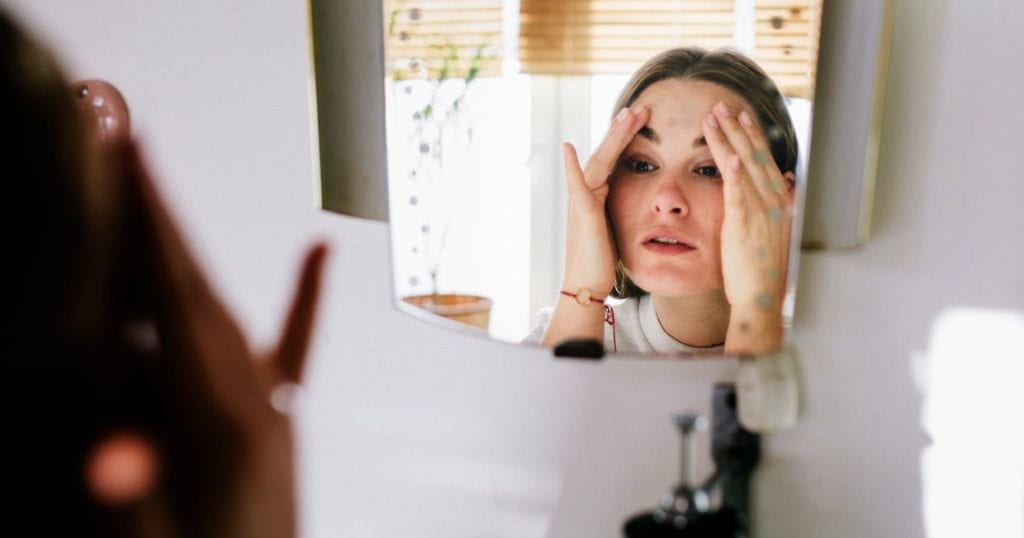While we hope that all doctors’ offices and clinics have stepped up their safety measures due to COVID-19, understandably patients are still on edge about going to in-person appointments. With many medical professionals limiting IRL appointments to emergency-only, it’s also tougher nailing down a slot nowadays. According to a survey performed by McKinsey last year, 46 percent of patients in the U.S. are now using telehealth to replace canceled healthcare visits — up from 11 percent in 2019.
Particularly in the dermatology world, telemedicine visits have created great flexibility for both patients and dermatologists alike so that it limits potential exposure to germs while still addressing your needs. Your doctor will likely use their own secure video platform to conduct your consultation/appointment, or it may be done over Zoom or FaceTime. Not to mention, we love how virtual appointments save us valuable time when we remove the travel factor, sitting in a waiting area, etc. Plus, it gives you access to doctors who are located in other states.
Since it’s likely that virtual appointments will be sticking around for a while, we explore what you can expect if you’re using telemedicine for the first time.
How to prepare for your virtual skincare appointment
There’s some business-as-usual stuff: If you’re a new patient, you’ll need to fill out forms about your health history beforehand and send them over electronically. From questions about a new mole to figuring out your new skincare routine, you can still ask your dermatologist anything you would in person, but now over video chat. Prepare your questions in advance like you would if you were meeting in person.
“Sometimes you can send a photo [of your specific skin concerns] ahead of time, to determine if it’s best to be seen virtually,” says Dr. Tsippora Shainhouse, M.D., F.A.A.D., a board-certified dermatologist. It could be helpful to send clear photos in advance regardless, as sometimes video quality isn’t good enough to see the details of your skin.

On that note, make sure your phone is charged and you have access to a good cell/internet service so the video isn’t choppy. A laptop, while the screen is larger, automatically reduces the quality of the video and it’s also harder to get your laptop camera in the right position (say, if you’re trying to show your doctor a new spot on your ankle). “While this isn’t very common, I’ve heard of some patients investing in portable dermatoscopes — smartphone attachments that help you take magnified, office-grade photographs of your skin. These can help the dermatologist get a more accurate “read” of your skin, and make a very accurate diagnosis from afar,” says Dr. Steven Shapiro, dermatologist and founder of Shapiro MD, whose clinic has seen an uptick of over 250% in telehealth visits over the last six months.
One of the great things about being able to conduct a dermatology appointment in the comfort of your own home is that you can give your doctor a better idea of what kind of products and ingredients you’re currently using in your skincare routine so that they can determine if they’re compatible to your skin goals. Get them together on your vanity in advance so that you’re ready to discuss your regimen.
Lastly, if you’re living with others, find a private and comfortable spot in your home to conduct your appointment. Depending on your skin issues, it might require taking off your clothes, so you don’t want to video chat right next to an open window like you might during a regular work-related Zoom call.
Which skin concerns can be treated virtually?
During your video consultation, your doctor will do their best to examine your skin to address any issues they may see, but the types of conditions they can treat over the screen are limited. “Telehealth visits are best when the problem area is localized so that it is visible by basic photography. These are mostly concerns that can be treated topically or with prescription medication as opposed to a procedure, like a biopsy, injection, laser, or surgery. We can look at a problem and prescribe a treatment regimen online, but we clearly cannot do any procedures online,” These visits are often appropriate for follow-ups after in-office procedures,” says Dr. Lisa Chipps, a dermatologist of Moy, Fincher, Chipps Facial Plastics &. Dermatology.

As long as your photos and/or camera are clear and high-res enough, telehealth could be a suitable option for issues like acne, rosacea, certain rashes, wrinkles, psoriasis, or eczema. Additionally, “certain skin infections that can be diagnosed based on the history and clinical appearance/pattern, without a culture can be treated by telemedicine (impetigo, shingles),” says Shainhouse.
There are devices like the FDA-approved TytoHome, that enables at-home medical exams on your skin (as well as other vitals and body parts like your ears, throat, lungs, heart, abdomen, and temperature) and sends the results to a remote physician to analyze.
What can’t be treated virtually by my dermatologist?
In-person appointments will never fully go away because they need that close-up examination to properly study and treat. This includes your annual skin checkup, any surgical procedures, or anything that might require a biopsy. If you have skin allergies (an allergic reaction may be initially evaluated by a virtual visit, but if injections or allergy testing are decided to be part of the plan, then an office visit would be necessary), warts, scalp lesions, mouth lesions, an in-person visit is the best route, according to Shainhouse.

Moles in particular are difficult to examine over video. “In the office, we use a dermatoscope, which is a special light that helps examine moles. If a suspicious lesion is seen in person, we can biopsy it on the spot,” says dermatologist Dr. Shari Sperling.
“If the background story is complicated, or the patient has a new or unusual diagnosis, then telehealth may not be the best option either,” adds Chipps.
Will telederm visits become part of the norm of a post-pandemic world?
When considering the future of dermatology post-pandemic, many dermatologists believe that telehealth visits will continue to be a regular part of their practices in conjunction with in-person appointments.
“Delivering health care in this way is truly a breakthrough. Teledermatology had been talked about for decades but never became mainstream. The pandemic forced us to adopt new ways of taking care of patients quickly. We found that we could diagnose and treat common issues at the same high-quality level patients were accustomed to with in-person visits. Telehealth is especially helpful in my field because patients need to remove their masks in order to have their entire face evaluated. During a virtual visit, there’s absolutely no risk of COVID-19 transmission,” says Dr. Lynn Sydor, MD, FAAD, Board-Certified Dermatologist on Dermatica’s Dermatology Team.
“When we eventually emerge from this pandemic, I’m sure the demand for this new way of providing dermatologic care will continue alongside traditional clinics and doctors’ offices. Virtual care offers a wide range of access to doctors and for many patients who do not have any health insurance, seeing a dermatologist virtually is more affordable than paying out of pocket to see an MD in the office. It’s a great solution for many patients,” says Lynn.







